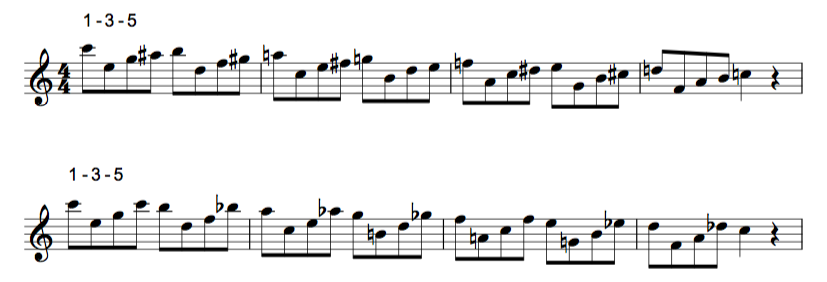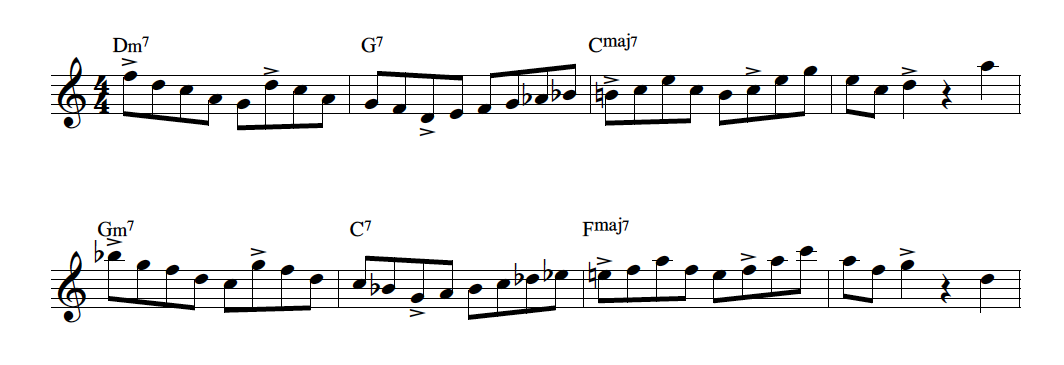From the beginning of my experience as an improvising musician, I have kept in mind the importance of cultivating a good ear. But for the longest period of time, my conception of what this meant was actually interfering with my progress.
In short, I used to define “having a good ear” in a rather rigid, intimidating way.
To my mind, having a good ear meant that I could easily, and immediately identify and play back absolutely anything I heard or imagined, no matter how complex or unfamiliar it was. It was a finite, “all-or-nothing” skill that I needed to obtain. (For the record, I don’t yet have skills at this level.)
The problem with this absolutist attitude was that it was overwhelming me. It seemed like such an arduous, daunting task, that I often procrastinated approaching it. And even when I had my periods of dedicated work, I never really developed a regular, systematic, disciplined way of studying.
Then I stumbled upon a book on ear training that had one sentence in it that completely changed my attitude, perception and, perhaps most important, my motivation. The book is called “Modus Novus: Studies in Reading Atonal Melodies”, by Lars Edlund, and was (and perhaps still is?) one of the standard ear training texts in many music schools for learning to hear and sing “modern” music.
The material in the book is challenging, and working through it has done a great deal to improve my ears. But, knowing myself as I was back then, I would never have had the perseverance to get through this seemingly daunting work had it not been for a simple idea expressed in this book. It was, in fact, stated in the very first sentence of the introduction:
“The main object of aural training should be to develop musical sensitivity.”
Yes, as simple as that.
“To develop musical sensitivity” seemed like such an open-ended, user-friendly, logical and completely non-intimidating idea. It sounded to me as being more an invitation than a demand. It was a direction to head toward, not a destination.
You see, as obvious as this may seem, I never thought of ear training in this way. To me it was an obtuse entanglement of difficulty, an abstract idea of sorts.
In my previous attitude, ear training was a plane to be reached by navigating through perilous waters. It meant learning not only to be able to identify and sing back every interval, but also, every chord in any inversion, every harmonic substitution or extension on any chord, any inversion of any chord, any melodic pattern (again, no matter how complex or unfamiliar), the sound of every note relative to any chord, not to mention being able to recognize and sing any scalar fragment, whether tonal or symmetrical.
All this and more. (I haven’t even mentioned transcribing any improvised solo I came across.)
Now don’t get me wrong. All the things I mention above are vital, useful skills to develop. But is was this simple idea of the deeper goal of ear training that put everything into perspective. It made me realize that I could work on my ear much more steadily and frequently, simply by changing my intention in what I practice.
Ear training transformed from the abstract into the concrete instantaneously. The beautifully empowering idea of developing musical sensitivity broadened my definition of what having a good ear was. It wasn’t just about identifying pitches and harmonies. It was about hearing and imagining music on a much deeper (and detailed) level:
It meant listening more closely to the color of the sound of my own instrument, to my articulations and dynamics.
It meant listening more mindfully to other musicians, hearing their nuances of expression.
It meant perceiving, understanding and hearing form and structure in all music I heard or played.
It meant being more open to the “non-musical” sounds around me, realizing that I can hear pitch and intervals in the sound a car engine makes, or of a barking dog.
It meant becoming more aware of how much rhythm there is in everything I hear: from music, to speech, to objects in nature… world itself.
It meant that I was singing more than I’d ever done before. I began singing every solo I listened to, every melodic pattern I practiced, every chord progression I practiced. Anything that moved me or interested me, I sang (and continue to do so).
What made all this so easy now was that I realized that I could aim toward getting “better ears”, instead of a “perfect ear”. I could accomplish a tangible goal every day. In every practice session I could say with great confidence that I had mindfully increased my musical sensitivity.
As my awareness and reception of sound began to expand, my desire (and the discipline that followed) to methodically improve my ear in regards to the “traditional” ear training skills mentioned above, took on a life of its own.
I shifted from a sense of obligation, to a sense of genuine curiosity and wonder. Passion to become even more sensitive to sound began to transform my musical practice in general. The more I could hear, the more I wanted to hear. I became hungry to find more and more ways to challenge my ears.
And so it is nowadays, as I continue to follow my love and curiosity.
So If you’d like to get on a lifelong path of improvement, embrace this simple wish of always improving your musical sensitivity. Begin today.
For sure, work on hearing and singing intervals, identifying harmonies, scales, etc., in a logical, progressive, methodical way. Definitely consider transcribing a solo that moves you deeply, or even just a simple melody. Just begin somewhere.
Make sure you are singing everything. Even in the practice room, sing more and play less. Make what you hear truly yours. Let it flourish and enrich your imagination.
Light your fire, and follow your heart. The music making experience will be so much richer for you if you do so.



